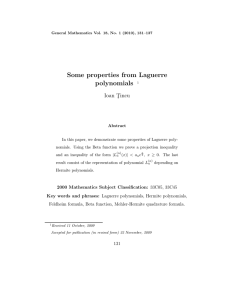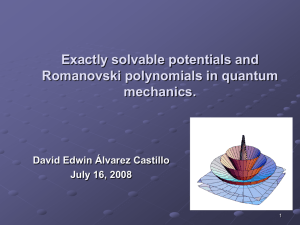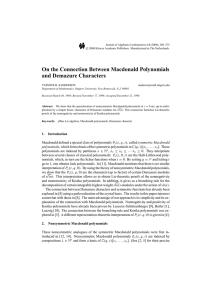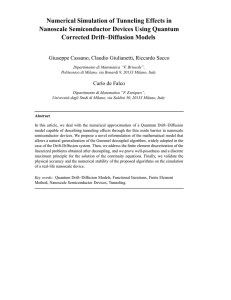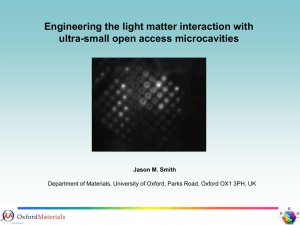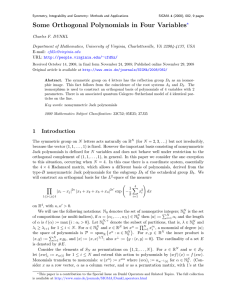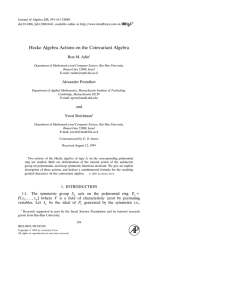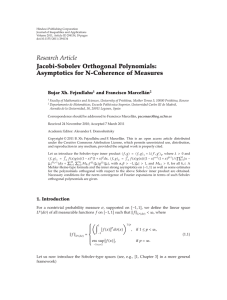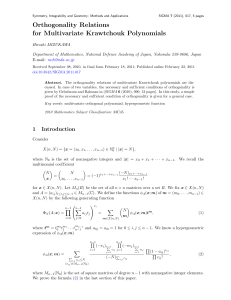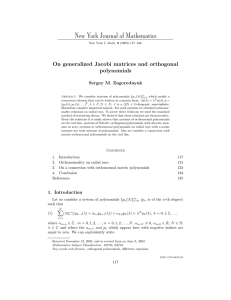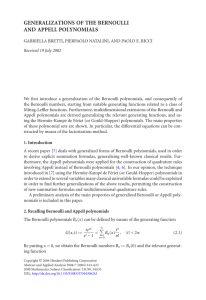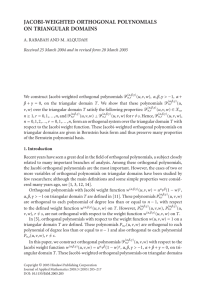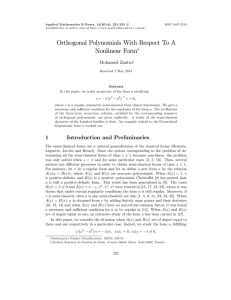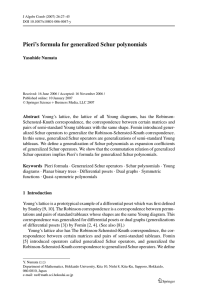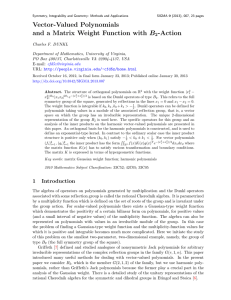Gromov-Witten Invariants and Schubert Polynomials
advertisement
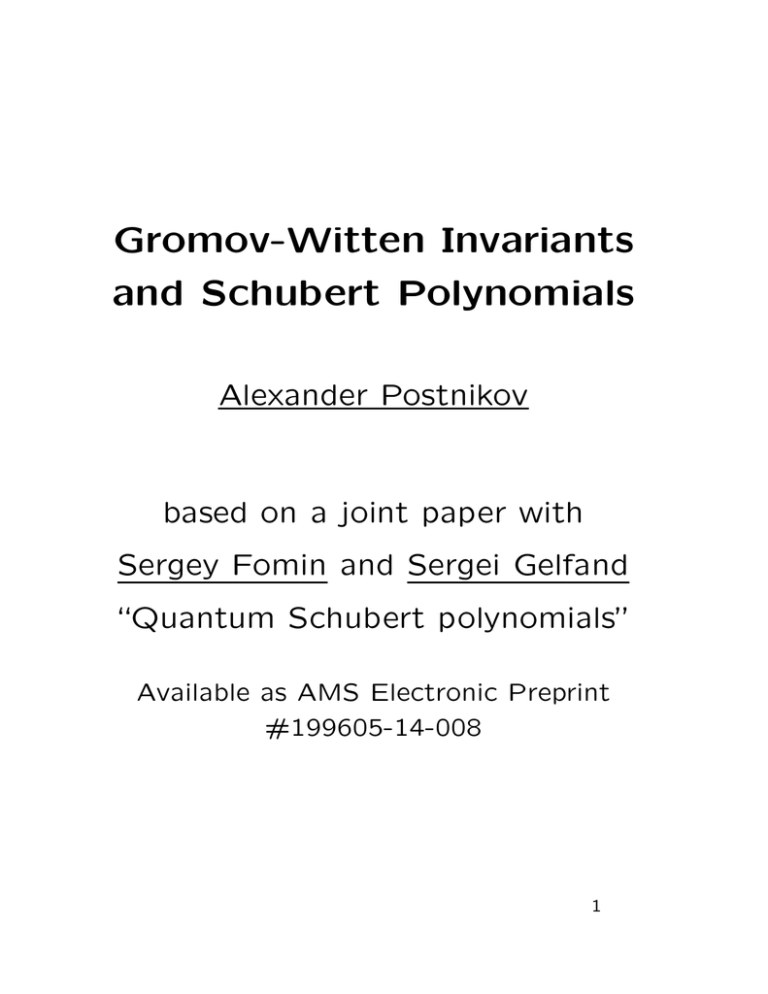
Gromov-Witten Invariants
and Schubert Polynomials
Alexander Postnikov
based on a joint paper with
Sergey Fomin and Sergei Gelfand
“Quantum Schubert polynomials”
Available as AMS Electronic Preprint
#199605-14-008
1
1. Flag Manifold
F ln = F l(Cn ) flag manifold. Points are
U 1 ⊂ U 2 ⊂ · · · ⊂ U n = Cn ,
dim Ui = i.
Homomorphism α : Z[x1, . . . , xn] → H∗ (F ln , Z)
α : xi 7−→ −c1(Ei/Ei−1) ∈ H2(F ln ),
where 0 = E0 ⊂ E1 ⊂ · · · ⊂ En−1 ⊂ En = Cn
are tautological vector bundles on F ln
and c1 is the first Chern class.
Theorem [A. Borel, 1953]
duces the isomorphism
The map α in-
∼
Z[x1, . . . , xn]/In −→ H∗(F ln , Z)
where In = (e1 , . . . , en) is the ideal generated by elementary symmetric polynomials in
x1 , . . . , x n .
2
Schubert Classes
Another description of H∗ (F ln ) is based on
a decomposition of F ln into Schubert cells,
labelled by permutations w ∈ Sn
Fix a flag V1 ⊂ V2 ⊂ · · · ⊂ Vn = Cn.
The Schubert variety Ωw is the set of all flags
U. ∈ F ln such that for all p, q ∈ {1, . . . , n}
dim(Up ∩ Vq ) ≥ #{1 ≤ i ≤ p, w(i) ≥ n + 1 − q}
Then codimRΩw = 2l(w), where l(w) is the
length of w.
Schubert class:
σw = [Ωw ] ∈ Hn(n−1)−2l (F ln ) ' H2l (F ln )
Theorem [Ehresmann, 1934] The classes
σw , w ∈ Sn , form an additive basis in H∗ (F ln , Z).
In particular, dim H∗(F ln ) = n! .
3
Q: How to multiply Schubert classes?
Q’: How to express a Schubert class in terms
of generators xi.
Answer (due to Bernstein, Gelfand,Gelfand)
can be given in terms of divided differences.
Divided differences
Sn acts on f ∈ Z[x1 , . . . , xn] by
w f (x1 , . . . , xn) = f (xw−1(1), . . . , xw−1(n)).
Let si = (i, i + 1) ∈ Sn (adjacent transposition).
The divided difference operators are given by
∂i f =
1
(1 − si) f
xi − xi+1
4
Schubert polynomials
Define the Schubert polynomials Sw , w ∈ Sn
recursively by
n−2
. . . xn−1,
x
Sw0 = xn−1
2
1
(the choice of Lascoux–Schützenberger [1982])
where w0 = (n − 1, n − 2, . . . , 1) is the longest
permutation in Sn, and
Swsi = ∂iSw whenever l(wsi ) = l(w) − 1.
Theorem [BGG, 1973] Sw represents Schubert class σw .
5
Sw0 = x21x2
Ss1 s2 = x 1 x 2
Ss1 = x 1
|
@
@@
@ @
@ @
@ @
@ @
@ @
@ @
@ @
@|
|
|
@
@
|
@
@
@
@
@
@
Ss2s1 = x21
Ss2 = x 1 + x 2
@|
Sid = 1
Schubert polynomials for S3
6
2. Gromov-Witten Invariants
and Quantum Cohomology
(see [Ruan-Tian, Kontsevich-Manin])
Structure constants of the quantum cohomology ring QH∗(X) are the Gromov-Witten
invariants (for genus 0).
An algebraic map f : P1 → F ln has
multidegree d = (d1 , . . . , dn−1) ∈ Zn−1
+ ,
di = degree of fi : P1 → F ln → Gr(n, i).
Md(P1 , F ln ) = moduli space of such maps.
For Y ⊂ F ln , t ∈ P1, denote
Y (t) = {f ∈ Md(P1 , F ln ) | f (t) ∈ Y }.
Gromov-Witten invariants: Fix t1 , t2, t3 ∈ P1.
f (t ) ∩ Ω
f (t ) ∩ Ω
f (t )
hσu, σv , σw id = # Ω
u 1
v 2
w 3
provided l(u) + l(v) + l(w) = dim Md(P1 , F ln )
f ,Ω
f ,Ω
f are generic translates of Ω , Ω , Ω .
Ω
u
v
w
u
v
w
7
Quantum multiplication
As an abelian group
QH∗ = QH∗ (F ln ) = H∗(F ln , Z)⊗Z[q1 , . . . , qn−1]
Let ∗ : QH∗⊗QH∗ → QH∗ be the Z[q1 , . . . , qn−1]linear operation defined by
σu ∗ σ v =
X X
w∈Sn d
q d hσu, σv , σw w0 id σw .
Then (QH∗, ∗) is a commutative and associative
algebra called the quantum cohomology ring
of F ln .
Remark: hσu, σv , σw i(0,...,0) is the ordinary
intersection number. If we specialize
q1 = · · · = qn−1 = 0, the operation ∗ becomes
the standard multiplication in H∗(F ln )
(the “classical limit”).
8
Quantum analogue of Borel’s theorem
Let E1, . . . , En be the quantum elementary
polynomials defined to be the coefficients of
the characteristic polynomial of the matrix
x1 q1 0
−1 x2 q2
0 −1 x3
..
..
..
0 0
0
0
0
0
···
0
0
···
0
0
···
0
0
..
..
...
· · · xn−1 qn−1
· · · −1
xn
Example: n = 3
E1 = x 1 + x 2 + x 3 ,
E2 = x 1 x 2 + x 1 x 3 + x 2 x 3 + q 1 + q 2 ,
E3 = x 1 x 2 x 3 + q 1 x 3 + q 2 x 1 .
Theorem [Givental, Kim, Ciocan-Fontanine,
1993–1996] There is a canonical isomorphism
∼
Z[x1, . . . , xn, q1, . . . , qn−1]/Inq −→ QH∗(F ln , Z)
q
where In be the ideal generated by E1, . . . , En.
9
3. Main Results
Q: How to multiply Schubert classes in QH∗?
Q’: How to calculate the Gromov-Witten invariants hσu , σv , σw id ?
Q”: How to express σw in terms of xi in the
ring QH∗.
H∗ (F ln ) ⊗ Z[qj ]
∼
=
?
k
QH∗(F ln )
Z[xi, qj ]/In
∼
=
Z[xi, qj ]/Inq
We will construct the isomorphism
Z[xi, qj ]/In −→ Z[xi, qj ]/Inq
(“quantization map”)
10
Standard elementary monomials
eki = the ith elementary symmetric polynomial in x1, . . . , xk and
Eik = the ith quantum elementary polynomial
in x1, . . . , xk .
For I = (i1, i2, . . . , in−1),
0 ≤ ip ≤ p
n−1
2
eI = e1
i1 ei2 . . . ein−1 ,
EI = Ei1 Ei2 . . . Ein−1
1
2
n−1
Lemma Both {eI } and {EI } are K-liner
bases in K[x1, x2, . . . ], where K = Z[q1 , q2 , . . . ].
11
Quantization map
Define the K-liner map ψ : K[x1, x2, . . . ] →
K[x1, x2, . . . ] by
ψ : eI 7−→ EI for all I
Remark. ψ induces a map
K n[x1 , . . . , xn]/In −→ K n[x1 , . . . , xn]/Inq
where K n = Z[q1 , . . . , qn−1 ].
Quantum Schubert polynomials:
Define
Sqw := ψ(Sw )
Theorem [FGP] The quantum Schubert polyq
nomial Sw represents the Schubert
class σw in
QH∗ ' Z[x1, . . . , xn][q1 , . . . , qn−1]/Inq .
12
Example
q
One can easily calculate the Sw using the
divided differences ∂i.
S4321 = Sw0 = e123;
S3421 = ∂1Sw0 = ∂1e123 = e023;
S3412 = ∂3e023 = (e22)2 = e022 − e013.
Sq3412
= E022 − E013
2 + 2q x x − q x2 + q 2 + q q .
= x2
x
1 1 2
2 1
1 2
1 2
1
13
Sqw0 = x21x2 + q1x1
|
@
@@
@ @
@ @
@ @
@ @
@ @
@ @
@ @
@|
Sqs1s2 = x1x2 + q1
|
Sqs1 = x1
|
@
@
|
@
@
@
@
@
@
Sqs2s1 = x21 − q1
Sqs2 = x1 + x2
@|
Sqid = 1
Quantum Schubert polynomials for S3
14
Axiomatic approach
q
The following properties of the Sw follow
from their geometric definition:
q
Axiom 1. Homogeneity: Sw is a homogeneous polynomial of degree l(w) in x1, . . . , xn,
q1 , . . . , qn−1, assuming deg(xi ) = 1 and
deg(qj ) = 2.
Axiom 2. Classical limit: Specializing
q
q1 = · · · = qn−1 = 0 yields Sw = Sw .
Axiom 3. Positivity of GW-invariants:
The cw
uv in
Squ Sqv
=
X
w
q
cw
S
uv w
are polynomials in the qi with positive integer
coefficients.
Axiom 4. Quantum elementary polynomials:
For a cycle w = sk−i+1 . . . sk , we have
Sqw = Ei(x1, . . . , xk ).
Proved by [Ciocan-Fontanine].
15
q
Theorem [FGP] The polynomials Sw (modq
ulo the ideal In) are uniquely determined by
Axioms 1–4.
q
q
Conjecture The polynomials Sw (mod In)
are uniquely determined by Axioms 1–3.
Checked for S3 and S4.
16
Quantum Monk’s formula
Let tab = (a, b) = sasa+1 . . . sb−1 . . . sa (transposition).
Theorem [FGP] We have
Sqsr Sqw
=
X
Sqwtab
+
X
q
qc qc+1 . . . qb−1Swt
cd
where the first sum is over a ≤ r < b such that
l(wtab ) = l(w)+1 and the second sum is over
c ≤ r < d such that l(wtcd ) = l(w) − l(tcd ).
q
Note that Ssr = Ssr = x1 + · · · + xr .
17
Commuting operators approach
Define the operators on K[x1, x2, . . . ]
Xk = x k −
X
i<k
qij ∂(ij) +
X
qkj ∂(kj)
j>k
where ∂(ij) = ∂i∂i+1 . . . ∂j−1 . . . ∂i+1∂i
and qij = qiqi+1 . . . qj−1 .
Theorem [FGP]
• The operators Xk commute pairwise and
K[X1 , X2, . . . ] is a free abelian group.
• For any g ∈ K[x1, x2, . . . ] there is a unique
polynomial G ∈ K[X1 , X2 , . . . ] such that
G : 1 7→ g.
• The map g 7→ G is the quantization map ψ.
q
In particular, eI 7→ EI and Sw 7→ Sw .
• Xi induces the operator of quantum multiplication by xi in Z[xi, qj ]/In ' H∗ ⊗ Z[qj ].
18
Examples:
Xi (1) = xi,
X1 X1 (1) = x2
1 + q1 ,
XiXi (1) = x2
i>1
i − qi−1 + qi,
XiXi+1 (1) = Xi+1 Xi(1) = xixi+1 − qi,
X1X1 X1 (1) = x3
1 + 2q1 x1 + q1 x2.
Thus we obtain
ψ : xi
ψ : x2
1
7−→ xi,
7−→ x2
1 − q1 ,
i>1
7 → x2
−
ψ : x2
i + qi−1 − qi,
i
ψ : xixi+1 −
7 → xixi+1 + qi ,
ψ : x3
7−→ x3
1
1 − 2q1x1 − q1 x2.
19
q
Three definitions of Sw :
q
1. Sw represents σw in QH∗.
2. Quantization map ψ : eI 7→ EI .
3. ψ : g(x1, x2, . . . ) 7→ G(X1 , X2 , . . . ).
20
